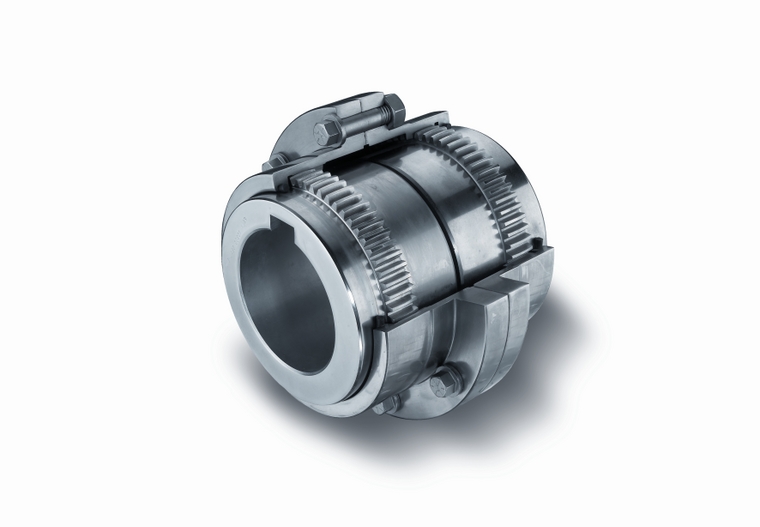Product Description
1.Small radial dimension and large bearing capacity are commonly used in shafting transmission under low speed and heavy load conditions.
2.It can compensate the relative offset of 2 axes in a certain angle and work long distance with the middle axle.
3.It is suitable for connecting horizontal 2 coaxial axes and driving shafting with a certain angle displaceme
Drum gear coupling, drum tooth is the external teeth made into a spherical, spherical center in the gear axis, side clearance than the general gear. The drum gear coupling can allow a larger angular displacement than the straight gear coupling. Moreover, the contact condition of the teeth is improved, so that the ability of transmitting torque is improved, and the service life of the coupling is prolonged. If the drum gear coupling to ensure safe and reliable work, good lubrication is essential, in exchange for slow wear. The high-speed drum-type gear coupling is mostly lubricated by lubricating oil, which needs to be filtered by high-precision oil filter, the filtrate is less than 10 microns, and the tooth surface requires continuous lubrication, otherwise the tooth surface temperature will increase and will accumulate moisture and dirt. Some high-speed drum-shaped gear couplings sometimes use the structure of oil-collecting groove hole, that is, the oil-collecting groove is processed in the outer gear shaft hole, and the oil hole which is communicated with the oil-collecting groove is drilled at the bottom of the outer gear groove, in order to make it fully lubricated, we rely on the drum-type tooth coupling high-speed operation of the centrifugal force, will be injected into the internal and external teeth mesh. Under the condition of angular displacement and stress concentration, the contact condition of the inner and outer teeth is improved by extrusion of the edge of the straight tooth, so that the friction and wear of the tooth surface are reduced and the noise is reduced. Under the same conditions, the load-carrying capacity of the drum-type gear coupling is increased by 15 -20% on average compared with the straight-type gear coupling in terms of the outer diameter of the inner gear sleeve and the maximum outer diameter of the coupling.
/* January 22, 2571 19:08:37 */!function(){function s(e,r){var a,o={};try{e&&e.split(“,”).forEach(function(e,t){e&&(a=e.match(/(.*?):(.*)$/))&&1

Misaligned Tooth Couplings: Challenges and Mitigation
Misalignment in tooth couplings can lead to various challenges that affect coupling performance and equipment reliability. Here are some challenges that can arise from misaligned tooth couplings and how they can be mitigated:
1. Increased Wear: Misalignment causes uneven loading and increased stress on the teeth of the coupling, leading to accelerated wear and potential tooth damage.
2. Reduced Efficiency: Misaligned couplings can result in energy losses due to increased friction and inefficient torque transmission.
3. Vibration and Noise: Misalignment can induce vibration and noise in the machinery system, affecting both operator comfort and equipment lifespan.
4. Premature Failure: Excessive misalignment can lead to premature coupling failure and unexpected downtime.
To mitigate these challenges, consider the following steps:
1. Proper Alignment: Ensure that the connected shafts are aligned within the specified tolerances. Use alignment tools and techniques to achieve accurate shaft alignment.
2. Regular Inspection: Perform routine inspections of the coupling to detect any signs of wear, damage, or misalignment. Address any issues promptly.
3. Lubrication: Proper lubrication reduces friction and wear, especially in misaligned conditions. Follow manufacturer guidelines for lubrication frequency and type.
4. Coupling Maintenance: Follow recommended maintenance practices provided by the coupling manufacturer to extend its lifespan and performance.
By addressing misalignment issues proactively and following proper maintenance practices, you can ensure the optimal performance and longevity of tooth couplings in your machinery systems.

Diagnosing and Addressing Issues with Tooth Couplings
Diagnosing and addressing issues related to tooth couplings within machinery systems involves a systematic approach to troubleshooting and maintenance:
- Visual Inspection: Regularly inspect tooth couplings for signs of wear, damage, misalignment, or corrosion.
- Abnormal Noises: Unusual noises during operation, such as grinding or clanking sounds, may indicate problems with tooth engagement or misalignment.
- Vibration Analysis: Excessive vibration can be a sign of misalignment or other issues. Use vibration analysis tools to identify the source of vibration.
- Temperature Monitoring: Elevated temperatures could point to problems like inadequate lubrication or excessive friction.
- Lubrication Analysis: Monitor the quality and level of lubrication to ensure proper coupling function and minimize wear.
- Alignment Check: Periodically check and adjust the alignment of connected shafts to prevent excessive load on the tooth coupling.
- Torque Measurement: Measure the transmitted torque to ensure it is within the coupling’s rated capacity.
- Replacement of Components: If wear or damage is detected, replace worn or damaged components promptly to prevent further issues.
- Professional Expertise: If problems persist or are beyond your expertise, consult with coupling manufacturers or specialists for guidance.
By regularly monitoring and addressing potential issues, you can ensure the reliable performance and longevity of tooth couplings in machinery systems.

Benefits and Applications of Tooth Couplings
Using a tooth coupling offers several key benefits in mechanical systems:
- High Torque Transmission: Tooth couplings can handle high torque loads, making them suitable for heavy-duty applications.
- Angular Misalignment: They accommodate angular misalignment between shafts, reducing stress and wear on components.
- Axial Movement: Tooth couplings allow limited axial movement, which is crucial in applications with varying distances between shafts.
- Compact Design: Tooth couplings have a compact design, making them ideal for applications with limited space.
- Efficient Power Transmission: The meshing teeth provide efficient torque transmission with minimal backlash.
Tooth couplings find applications in various industries:
- Manufacturing: Used in conveyor systems, pumps, compressors, and machine tools.
- Automotive: Used in drivetrains, power transmission, and steering systems.
- Marine: Used in marine propulsion systems, winches, and deck machinery.
- Power Generation: Used in turbines, generators, and cooling tower fans.
- Aerospace: Used in aircraft control systems, landing gear, and engine accessories.


editor by CX 2024-04-25
by
Tags:
Leave a Reply